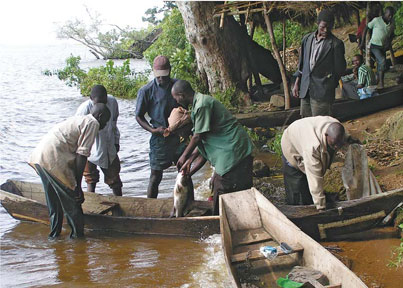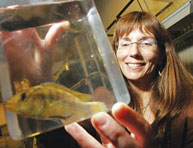Lake Victoria is Africa’s single most important source of inland fishery production, but radical changes to its ecology have rendered much of the deep water anoxic (no oxygen) or hypoxic (low in oxygen) and dramatically altered the food web. Other, more recent changes in the lake, however, are giving respiratory ecologist Lauren Chapman renewed hope that fisheries sustainability and biodiversity conservation can be reconciled.
By James Martin

Lake Victoria was a haven for haplochromine cichlids and heaven for evolutionary biologists; over time, the small fish evolved into more than 500 related, yet distinct, variations not found elsewhere, making the lake irresistible to researchers. Then, on a fateful day in 1954, a few non-native Nile perch were dumped into Victoria’s waters. The idea was to bolster a flagging fishing industry with a hearty new species. From the shore, the experiment appeared to fail, but a bloody revolution churned slowly, silently beneath the waves. By the 1980s, the world’s largest tropical lake swarmed with insatiable six-foot, 300-pound predators.
While the three countries that share Victoria’s waters (Kenya, Tanzania, Uganda) enjoyed a booming Nile perch export market, the World Conservation Union, an international network of government agencies and NGOs, ranked the voracious fish among the top 100 “worst invasive alien species.” The problem isn’t just that Nile perch devour cichlids and the lake’s other native species (although the upsurge of Nile perch in the 1980s coincided with the demise of about half the cichlid populations): the perch’s higher than most oil content also set off a calamitous domino chain. Fishermen need to build bigger fires to dry their oily catch. Bigger fires require more firewood. Fewer trees increase erosion. Erosion boosts the lake’s nutrient level (eutrophication) as soil tumbles into the water. Eutrophied waters nurture an unnaturally dense plant population, which dramatically upsets the delicate eco-balance. The result: an economically lucrative, ecologically devastating situation. But does a fisherman’s bonanza necessarily spell curtains for biodiversity?
Lauren Chapman sees a light, albeit faint. There’s no doubt Lake Victoria has seen catastrophic loss in recent years, but she believes a balance can be struck between environmental conservation and maintaining an industry that annually exports over $200-million in perch.
Twice a year since 1990, the McGill professor of biology has been setting up camp at the Makerere University Biological Field Station in Kibale National Park. Established in 1970 by Uganda’s leading research university, MUBFS does more than just give international researchers access to a wide variety of ecosystems. “In Uganda at least, there’s a lack of training resources,” explains Chapman, who works with several Ugandan grad students each year. “So international academics play a really important role in conservation by training graduate students—especially students who already have a position they’re going to return to and make a difference.”
From her MUBFS base, Chapman makes expeditions to the Lake Victoria basin, as well as the region’s swamps, crater lakes and rivers. “One of the things that brought me to Africa was my interest in environmental stressors in aquatic systems and adaptations of fishes to extreme environments,” Chapman recalls. “I’m particularly interested in low-oxygen (hypoxic) stress, which occurs naturally in some systems, like heavily vegetated swamps or the bottoms of deep lakes or flooded forests in the Amazon or the Congo.”
East Africa’s bountiful papyrus swamps are extremely hypoxic—and, for Chapman, a very useful model system for exploring adaptations to low-oxygen stress. There, her team discovered novel responses to extreme hypoxia; the researchers are now exploring the role of oxygen in the evolution of biological diversity in fish. By rearing fish under different oxygen conditions back at McGill’s Stewart Biological Sciences Building, she can detect hypoxia-induced changes in morphology, physiology and behaviour.

Chapman’s initial interest in how fish adapt to naturally extreme environs is very relevant to Victoria’s crisis. “Human-induced changes to the watershed—increased population density, expanding agriculture, deforestation—are becoming a real problem in the Lake Victoria basin, which serves 30 million people,” says Chapman. “Large pieces of the lake bottom are permanently anoxic; these sometimes upwell, leading to fish kills.”
However, low oxygen has its advantages. Some fish have actually used hypoxia to sidestep the Nile perch: during the 1990s, Chapman and her colleagues discovered that Nile perch are sensitive to hypoxia, allowing some native fish to find refuge in hypoxic wetlands bordering the lake. Over time, as the Nile perch is heavily fished, she’s also watched certain cichlids recover. In Lake Nabugabo, a Victoria satellite lake touched by the Nile perch, Chapman has seen the cichlid population go from almost nothing in the early 1990s to regaining their place as a major player in the food web. “Now we’re seeing even more changes to the system,” she says, “changes to the distribution of the wetland, and changes in ecology of the Nile perch. It’s really important to look at these systems for a long time, which is hard to do these days when a lot of funding is directed toward shorter-term projects.”
Chapman’s work has contributed to a growing awareness of the importance of wetlands as both refuges for native fish and nursery areas for commercially important fish. In 1995, Uganda issued a national wetlands policy, curtailing drainage and insisting that all users adopt sustainable practices. Community-based conservation efforts focus on specific wetlands, working on ways to use these habitats in sustainable ways (e.g., fishing, harvesting plant materials for use in construction, ecotourism) rather than large-scale conversion to agricultural land.
The Nile perch, meanwhile, continues to respond to the cascading effects of its own introduction. When they first entered the Lake Victoria system, the perch fed on haplochromine cichlids. In fact, they liked eating cichlids so much that young perch fast-tracked the transition from an insect diet to a fish one, making the leap when they were a mere 5 to 15 centimetres long. When cichlid levels got too low, the perch were forced to feed on Rastrineobola argentea (a native minnow), Caridina nilotica (a native shrimp) and even their own young; faced with this B-list fish diet, young perch tended to stick to insects until they were over 30 centimetres long. “It’s thought that the perch grow fastest when they’re feeding on haplochromine cichlids,” says Chapman.
The last 10 years have seen Victoria’s cichlid population on the upswing (possibly due to heavy perch fishing, thus reducing the cichlid’s predator population), and the Nile perch are once again feeding on their preferred prey. This makes for an interesting relationship between the lowly cichlid and big business. “If haplochromines are what perch like best to feed on,” says Chapman, “then haplochromines are good for the Nile perch industry. So, if you want to reconcile biodiversity loss with fishing, there may be an optimal level where the Nile perch are at a certain level, but you’re also allowing a haplochromine resurgence. That’s something that has renewed interest in a marriage of biodiversity conservation and fishery sustainability.”
Chapman and her colleagues are now exploring the pace at which native fish respond to environmental factors (hypoxia, Nile perch), and have found evidence for rapid morphological change (increase in gill size, change in body shape) in response to decades of stress. “This is adaptive change on a contemporary time scale; some of the Victoria fishes have changed very, very quickly in response to these strong selective pressures.” A major goal now is to understand the mechanisms underlying the changes. “Are we seeing heritable change—changes passed down to the next generation—and/or environmentally induced change within the lifetime of an individual? What happens when the stressors are relaxed?”
Uganda may prove a valuable role model for the rest of the world. “Due to the increasing influx of municipal wastes and fertilizers, hypoxic stress in fish is really becoming a global issue,” says Chapman. As an example, she cites the Gulf of Mexico, where springtime fertilizer run-off creates an annual oxygen-starved “dead zone” (estimated to be the size of New Jersey, and growing) unable to support ocean life.
“I think the work we do in the wetlands of Uganda has important implications for just how mosaics of wetlands can affect fish distributions and divergence. We’ve made some strides in understanding adaptations of fishes to low-oxygen stress and we can now apply that understanding to fishes that are going to experience that. The consequences for fishes of hypoxic stress need to be more fully understood, and there’s a big interest in doing this.”

Professor Chapman is the Canada Research Chair in Respiratory Ecology and Aquatic Conservation. Her research has received funding from the National Science Foundation, USAID, the Wildlife Conservation Society, the National Geographic Society and the Natural Sciences and Engineering Research Council of Canada.
